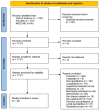Self-Esteem and Risk Behaviours in Adolescents: A Systematic Review
- PMID: 38920764
- PMCID: PMC11201250
- DOI: 10.3390/bs14060432
Self-Esteem and Risk Behaviours in Adolescents: A Systematic Review
Abstract
Adolescence is recognised as a notoriously vulnerable period in the human life cycle. Influenced by a complex interplay of biological, psychological and social factors, adolescents show a marked propensity to engage in risk behaviours. A systematic review was conducted of studies published in the Web of Science, PsycInfo and MEDLINE databases over the last decade, with the aim of collecting studies on the relationship between self-esteem and risk behaviour in individuals aged 12-18 years. The aim was to confirm the role of high self-esteem as a consistent protective factor against risk behaviour. The results show that self-esteem is negatively related to risk behaviour. Our results also reflect the need for further research on how sociodemographic factors, among others, affect the relationship between self-esteem and risk behaviours. This review highlights the relevance of implementing specific educational interventions to strengthen self-esteem in adolescents, with the aim of preventing various risk behaviours that may emerge during adolescence and persist throughout life if not addressed early.
Keywords: cross-sectional studies; risk behaviours; self-esteem; systematic review.
Conflict of interest statement
The authors declare no conflicts of interest.
Figures
Similar articles
-
Longitudinal relations among perceived parental warmth, self-esteem and social behaviours from middle childhood to early adolescence in China: Disentangling between- and within-person associations.Br J Psychol. 2023 Nov;114(4):969-990. doi: 10.1111/bjop.12672. Epub 2023 Jun 23. Br J Psychol. 2023. PMID: 37350569
-
Lifestyle habits, health indicators and sociodemographic factors associated with health-related quality of life and self-esteem in adolescents.Clin Child Psychol Psychiatry. 2024 Apr;29(2):493-512. doi: 10.1177/13591045231200661. Epub 2023 Sep 1. Clin Child Psychol Psychiatry. 2024. PMID: 37658652
-
Health-related quality of life is strongly associated with self-efficacy, self-esteem, loneliness, and stress in 14-15-year-old adolescents: a cross-sectional study.Health Qual Life Outcomes. 2020 Nov 2;18(1):352. doi: 10.1186/s12955-020-01585-9. Health Qual Life Outcomes. 2020. PMID: 33138833 Free PMC article.
-
The paranoia as defence model of persecutory delusions: a systematic review and meta-analysis.Lancet Psychiatry. 2018 Nov;5(11):913-929. doi: 10.1016/S2215-0366(18)30339-0. Epub 2018 Oct 9. Lancet Psychiatry. 2018. PMID: 30314852
-
Psychological interventions to improve self-management of type 1 and type 2 diabetes: a systematic review.Health Technol Assess. 2020 Jun;24(28):1-232. doi: 10.3310/hta24280. Health Technol Assess. 2020. PMID: 32568666 Free PMC article.
Cited by
-
Self-reported knowledge, attitude and mental health status of in-school adolescents in Nigeria.Afr J Prim Health Care Fam Med. 2025 Apr 10;17(1):e1-e8. doi: 10.4102/phcfm.v17i1.4858. Afr J Prim Health Care Fam Med. 2025. PMID: 40336415 Free PMC article.
-
Family Economic Hardship and Non-Suicidal Self-Injury Among Chinese Adolescents: Relative Deprivation as a Mediator and Self-Esteem as a Moderator.Behav Sci (Basel). 2024 Dec 22;14(12):1234. doi: 10.3390/bs14121234. Behav Sci (Basel). 2024. PMID: 39767375 Free PMC article.
References
-
- Álvarez-García D., Núñez A., Pérez-Fuentes M.D.C., Vallejo G. Efecto del grupo-clase sobre la cibervictimización en estudiantes de Secundaria: Un análisis multinivel [Class-level effects on cybervictimization in secondary students: A multilevel analysis] Rev. Educ. 2022;397:153–178. doi: 10.4438/1988-592X-RE-2022-397-543. - DOI
-
- UNICEF Adolescentes y Comportamientos de Riesgo. 7 June 2023. [(accessed on 1 April 2024)]. Available online: https://www.unicef.org/parenting/es/salud-mental/adolescentes-y-comporta....
-
- Ahumada-Cortez J.G., Gámez-Medina M.E., Valdez-Montero C. El consumo de alcohol como problema de salud pública. Rev. Cuba. Hig. Epidemiol. 2017;13:13–24. doi: 10.35197/rx.13.02.2017.01.ja. - DOI
-
- Salas F.G. Caracterización de factores implicados en las conductas de riesgo en adolescentes: Characterization of factors involved in risk behaviors in adolescents. Rev. ABRA. 2018;38:1–16. doi: 10.15359/abra.38-56.3. - DOI
-
- Rosabal E., Romero N., Gaquín K., Hernández R.A. Conductas de riesgo en los adolescentes: Risk behavior in adolescents. Rev. Cub. Med. Mil. 2015;44:218–229.
Publication types
Grants and funding
LinkOut - more resources
Full Text Sources


